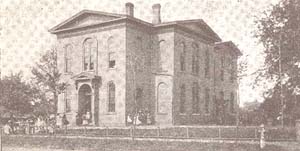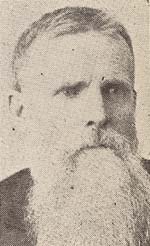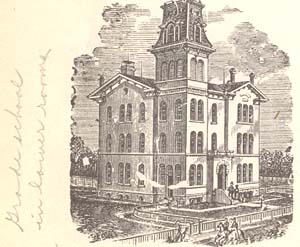|
WHAT was the town of
Decatur doing about schools a hundred years ago? In 1829, when
the town was laid out, there probably were not enough people around
the site of the town to make a school necessary, but by the
following year the situation had changed. The earliest school
inside the new town, of which mention has ever been made, was in
1830. Mrs. Marietta Packard King used to tell that when she
came in that year school was being held in a small room on South
Main street. After the log court house was put into use school
was held there in 1831 and 1832, with Daniel McCall as teacher.
Probably that continued to be the location for school sessions for
several years for we have no mention of other schools until 1839,
when the Christian church was rented as a school room. Nathan L.
Krone often mentioned a school held in a house on East William
between Franklin and Jackson streets, near the Town branch, which he
attended in 1843. He thought the teacher was Thomas H. Rogers.
Others have mentioned Lemuel Allen and Miss Fordyce as having taught
in that building. When that school house burned down a house
on Jackson street was secured.1 In 1842 citizens were
discussing the matter of a school building and a plan was made where
by the Masons would join them in the undertaking. As a result
a two story building was erected at the corner of Water and North
Park streets, the lower room being used for a school and the upper
room for a lodge room. This was really Decatur's first school
building. In 1856 the school trustees sold their share in the
property to the Masons. PRIVATE SCHOOLS For
twenty-five years Decatur had only subscriptions and private
schools. One of the best known and most influential private
schools was conducted by Mrs. Almira Avery Powers. She began
teaching in 1849, Mrs. Powers had been a teacher before her
marriage. Her sister, Miss Maria Giles, had been teaching a
class of young women in a room on Franklin street. Mrs. Powers
taught for seven years, first in her home, later in the Masonic
temple and in a brick building on West North street. Many have
been the tributes paid to the influence of Mrs. Powers as a teacher
in those days. After Mrs. Powers gave up her school, Miss Tempy
Short of Quincy became principal of a school here. Another school
which stands out prominently in early history was the school
conducted by Rev. John W. Coleman, in the basement of the First
Methodist church, which stood at Prairie and Water streets.
The school was started in 1855 and continued until just before
Christmas, 1857. Subjects of high school grade were offered in the
Coleman school. It became a flourishing institution, and Mr.
Coleman had a number of assistant teachers. They were his
wife, Mrs. Nancy Ela Coleman, her sister, Miss Maria Ela; Miss Lyda
Powell and W. Bramwell Powell. The latter became the father of
the famous violinist, Maud Powell. Mr. Coleman was considered one
of the most remarkable teachers Decatur has ever had, though his
school lasted for a comparatively short time. He was obliged
to discontinue it because of ill health. When he closed his
school he held a school exhibition in the Powers hall, that was such
a successful event that it was talked about for years afterwards.
In later years, after Mr. Coleman's health had improved, he was
employed as a bookkeeper for Stamper & Condell, merchants, and also
several as township collector. He died the day after signing
his final report, Feb. 17, 1869. In the '60s a private school for
boys was conducted by Mrs. Ichabod Baldwin on West Main street.
This probably was the first exclusive boys' school. Decatur was
one of the first school districts in Illinois to take advantage of
the Act of 1849, which gave a district authority to vote a local tax
for school support. In 1851 a tax of ten cents on the $100
assessed valuation was voted for the repair of the "brick school
house." This is supposed to have been the building occupied
jointly with the Masons. The vote was 30 to 12.
PUBLIC SCHOOLS Public school history of Decatur begins with the
passage of the school law Feb. 15, 1855, which provides for the
taxing of all the people of the state for the education of all
children in the state, and requiring that all the districts maintain
schools free to the children for at least six months of each year.
That year tax was levied in Decatur district for the purpose of
building a school house. As a result, Decatur had its first
building erected exclusively as a public school. It was
located at the northwest corner of Church and North streets and was
known as the Big Brick. Today the site is occupied by the E.
A. Gastman school.

THE "BIG BRICK"
(SHARON WICK'S NOTE: My
grandmother wrote in pencil "Mother went to this school" She
was referring to Sarah Elizabeth Grindle) The site at that
corner was purchased June 19, 1855, for $800 from Elisha D. Carter
and Christiana, his wife. It is described as lots 1, 2, 3, 4,
5, Block 8, Bandy's addition.
The new school building was started the next year by the
directors, J. J. Peddecord, E. O. Smith and P. B. Shepherd. On
the first floor were two good sized rooms, and recitation room
adjoining each, and on the second floor were one large room and two
small recitation rooms. The new building was opened in the
fall of 1857, with J. H. Remsburg as principal and David L.
Bunn and
Helen E. Parsons as assistants upstairs. Remsburg had
previously conducted a private school. In 1879 an addition was
made to the Big Brick.
The Decatur school district received a gift of a lot for school
purposes, but never used the lot as a school site. The gift
came from David L. Allen, who conveyed to the district April 14,
1856, Lot 1, Block 3, Allen, McReynolds & Co.'s addition, and 10
feet of the west side of Lot 4 of the same block. This was the
site now occupied by the Citizens bank.
When Decatur was laid out, a lot was reserved for school
purposes, but there is no record to show that it was ever so used.
The lot, which was the gift of Captain Allen, was sold Dec. 2,
1856, to Macon lodge, No. 8, A. F. and A. M. for $1,000.
The first meeting of the school board of directors of which
record has been preserved, was held Nov. 30, 1858, members present
being A. T. Hill and J. P. Boyd. It was determined at that
meeting to open a school in the lower room of the Masonic building.
Evidently school enrollment was growing. Miss Mary C. Bassett
of Maroa was engaged as teacher of the new room and her salary was
to be $35 a month. Besides teaching, she was expected to build
the fires and keep the room in order.
The first report now available on school enrollment was made Dec.
2, 1858. It showed the following figures:
First ward - D. L. Bunn, 140 scholars
First ward - Miss M. C. Bassett, 27 scholars
Second ward - J. A. Johnson, 150 scholars
Second ward - Assistant, Miss Ela, 105 scholars
Fourth Ward - Miss Juliet M. Bradley, 30 scholars
Second ward - Miss Roe, sick and unable to be in school.
School enrollment continued to increase and it was difficult to
find rooms for school purposes. Basements of the Methodist,
Presbyterian and Baptist churches were rented.
E. A. GASTMAN
One day in 1860 a man came down from Hudson, Ill., and asked for
a job as school teacher. He was hired as the principal of the
primary department at the Big Brick. The board then was
composed of A. T. Hill, S. K. Swingley and Dr. E. W.
Moore.
That was the beginning of a life sentence for Enoch A. Gastman
in the Decatur schools. The following year he was made head of
the high school, and superintendent of schools, a position he held
the rest of his life. His term of service as superintendent
was the longest in the history of American schools, 46 years.
With Mr. Gastman's constructive leadership, the Decatur
schools were brought to a high degree of efficiency. He was a
wise and conservative director of education, keen minded - the type
needed in a fast growing city.

E. A. GASTMAN
(SHARON WICK'S NOTE: My
grandmother wrote in pencil "Remembers him" She
was referring to Sarah Elizabeth Grindle remembering E. A. Gastman)
The need for something different in school government was
recognized and Decatur asked the legislature for a special charter,
designed after the charter previously granted Rock Island. The
school law then in effect was designed especially for rural schools
and was not adequate for a growing city. The bill for teh
special charter was introduced by Isaac C. Pugh of Decatur,
then serving as representative. It passed both houses and was
approved by Governor Oglesby Feb. 16, 1865. This
charter provides for a school board of three members, elected from
the district at large. The Decatur schools have been operated
under this charter until the present day. The first board,
under the new charter, was composed of William L. Hammer,
David P. Bunn and Caleb C. Burroughs.
Decatur's next school building, after the Big Brick, was the
Third ward school, afterwards known as the Wood street school, and
later replaced by the Mary W. French school. The first
two rooms of this building were erected by in 1863. The Jones
school on North Water street was constructed in 1864. In 1866
the Fourth ward (Jackson street) school was built, and in 1867 the
First ward (Sangamon street) building was erected.
Contract for the first unit of the high school building, which
stood for many years at North and Broadway streets, was let in 1868,
and the building was occupied in September, 1869. Since 1862
high school sessions had been conducted first in the Big Brick, then
in the basement of the Baptist church.
The first session of high school was held Sept. 22, 1862, in the
east room of the Big Brick.2 E. A. Gastman was
principal, and thirty-nine pupils were enrolled. The first
high school commencement exercises were held June 20, 1867, at
Powers hall. There were four graduates, all girls. The
were Emma Hummell, Rachel Hummell, Alice Roberts and
Emmaretta Williams.

FIRST HIGH SCHOOL
(SHARON WICK'S NOTE: My
grandmother wrote in pencil "Grade school in lower rooms)
In 1869 Miss Mary W. French began her long and successful
career as a teacher, retiring in 1912.
In 1870 S. S. Jack was named high school principal, and Mr.
Gastman gave all his time to the superintendency of schools.
Sine the days of Mr. Jack, the following have served as high
school principal: Oscar F. McKim, I. E. Brown,
J. N. Wilkinson, John W. Gibson, Walter A. Edwards,
C. M. McMahon, Luis B. Lee, James J. Sheppard,
Frank Hamsher, Sheridan W. Ehrman, Jesse H. Newlon,
Thomas M. Deam, Otto Weedman, and R. C. Sayre.
Decatur school officials have always found difficulty in keeping
up with the fast growing school population. One building after
another was followed in quick successsion. Other school
structures erected before 1900 were the Jaster street, 1882,
Marietta street, 1884, Warren, 1890, H. B. Durfee, 1892,
Pugh, 1895, and Oakland, 1896. Some of the earlier buildings
have given way to newer and more modern structures. The E. A.
Gastman school now occupies the site of the Big Brick.
Sangamon, Jackson and Jasper schools and the old high school
building are no more, their places being taken by new buildings in
more advantageous locations. Marietta school was replaced by
the new Lincoln school. Additions have been made to many of
the original buildings still in use.
New school buildings erected since 1900 are E. A. Gastman,
Roach, Dennis, Ulrich, Roosevelt junior high, Washington, Johns
Hill junior high, Washington, Johns Hill junior high,
Centennial junior high, Riverside, Garfield, Oglesby, U. S. Grant,
Mary W. French, Lincoln and Decatur high
school. All are in keeping with the advance of Decatur as a
city.
Some of the former prominent school board members have been
remembered in naming schools. They were H. B. Durfee,
John K. Warren, James G. Roach, and John Ullrich.
Pugh school was named after General Isaac C. Pugh, and E. A.
Gastman after the man who served so long and so successfully
as superintendent of schools. Oglesby school was named for
Richard J. Oglesby, war general, governor and senator.
The first woman member of the Decatur board of education was Mrs.
Isabella T. Stafford, who served from 1892 to 1895.
Since then there as always been a woman on the board.

ISABELLA T. STAFFORD
Decatur school pupils today number 10,600, and teachers 354.
An important feature of school life today is the work of the
Parent-Teachers associations. Each school has its own
organization, and together they make up the city association.
Superintendent E. A. Gastman passed away in 1907, shortly
after he retired from the position of head of the Decatur school
system. Superintendents which have followed him. H. B.
Wilson, J. O. Engleman, J. J. Richeson and
William Harris, have continued the wise supervision begun in
his time. Decatur's school system today, unexcelled in
leadership, teaching force and buildings, is the product of a
century of progress.
BUSINESS COLLEGE
In 1884 H. S. DeSoller started a business college in
Decatur. In two or three years he sold it to Horatio Nelson,
who in August, 1889, sold to G. W. Brown of Jacksonville.
Ever since then it has been known as Brown's Business college.
Mr. Brown installed E. P. Irving as principal.
About 1913 Mr. Brown sold the college to Peck and
Read of St. Louis, and in 1914 they sold to H. M. Owen,
present owner.
Mr. Owen, whose home was in Stonington, came to Decatur in
1891 from Davenport, Ia., and he and Henry D. Goshert of
Warsaw, Ind., opened the Decatur Business university in the
Syndicate block. In 1894 Mr. Owen succeeded Mr. Irving
as principal at Brown's and merged his own school was the college.
It is estimated that more then 19,000 young people have attended the
business college since its beginning.
------------
1.
This school building came to its
disastrous end, due to the zeal of one of its pupils. It was
customary for the boys to take turns at making the fire at the
schoolhouse in the mornings. One boy didn't do a very good job
at it and was censured for it. He agreed to do better.
When his turn came again he remembered that he must make a good
fire. He started the blaze and laid on the wood. As the
flames leaped up he piled on more wood. But alas, his fire
turned out to be too good, for it was more than the chimney could
stand, and by the time the other pupils arrived the building was in
ashes.
2. When the
high school was opened, it had no library, the only reference books
being those that belonged to the principal. This state of
affairs existed for several years, while school instructors were
wondering how they could secure a library. Finally three
teachers, Emily Moeller, Carrie Jamison, and Jane
Hamand, decided to start the movement by soliciting
subscriptions for the purchase of books. A few days of patient
canvassing resulted in a total of $1.50 with which to start a
library! The principal invested the money in a volume of
Cleveland's Compendium of English Literature. That was the
beginning of the Decatur high school library.
<PREVIOUS> <NEXT>
<CLICK
HERE TO RETURN TO TABLE OF CONTENTS>
|